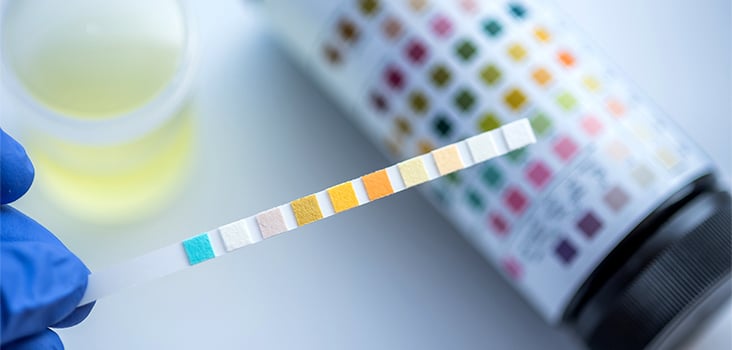
What You Need to Know about Pre-employment Drug Tests
Lawrence E. Buirse | Last updated 06/21/2023
There are several preventive services an employer can take advantage of to improve workplace safety, such as personal protective equipment (PPE) training and worksite risk analyses. Another cost-saving, preventive measure is pre-employment drug tests. Investment in pre-employment drug testing can help reduce costs because employers spend an estimated $276 billion annually in direct medical costs, lost productivity, absenteeism, increased health care costs, and more due to drug use.
What is a pre-employment drug test?
A pre-employment drug test is used to determine if a prospective hire uses illicit substances or abuses prescription medication. It may also be used for employees who are returning to work after an injury or absence, at which time it may be referred to as a pre-placement drug test. It is common for employers to require a job candidate to complete a pre-employment drug test, and a job offer may be contingent upon the applicant’s ability to pass. These drug tests typically screen for the use of the following illegal drugs (but can test for others if needed):
- Methamphetamines (meth, speed, crank, ecstasy)
- THC (cannabinoids, marijuana, hash)
- Cocaine (coke, crack)
- Opiates (heroin, opium, codeine, morphine)
- Phencyclidine (PCP, angel dust)
Drug testing specimen types
The most prominent drug testing specimen types are urine, hair, blood, and saliva. Urine is the most common and is mandated for regulated drug tests, such as those conducted by the U.S. Department of Transportation (DOT).* However, urine testing has a shorter window of detection when compared to other types, such as the costlier hair drug test. Many illicit substances are detectable for only five to 10 days in urine; whereas, hair drug tests can detect drug or alcohol use for up to 90 days.
Blood testing is very accurate, but costly and invasive. It does have a shorter detection period (minutes to hours), however. Finally, a saliva test (also known as an oral fluid test) is a less-invasive test that also has a shorter detection period (2-48 hours) than urine tests. A saliva drug test can be an effective alternative to urine testing if an employer wants to avoid issues that arise when an employee does not provide sufficient urine. Additionally, oral fluid tests can help employers better understand whether the employee used drugs while on the job and/or was impaired at the time of a workplace accident or injury.
*In May 2023, some DOT agencies (FMCSA, FAA, FRA, and FTA) amended the DOT-regulated industry drug testing program to include oral fluid testing, effective June 1, 2023, provided two labs are HHS certified/approved. As of 06/21/2023, the DOT has not yet certified a specified collection device for regulated oral fluid drug tests.
Why employers should require pre-employment drug testing
If workplace safety is of the utmost importance to a company, then conducting pre-employment drug tests can help mitigate risks associated with drug misuse. By indicating on a job application that an offer of employment may be contingent on the results of a drug test, an employer can help to deter substance abusers from applying altogether. For occupations that place employees in safety-sensitive environments, pre-employment drug testing is critical, as it can help reduce the number of costly workers’ compensation claims involving drug or alcohol use.
According to the National Institute on Drug Abuse (NIDA):
Drug use may represent as much as a five-fold increase in workplace injury claims
Up to 50 percent of all workers’ compensation claims are related to workplace substance abuse
Substance impairments may lead to 3.5 times more accidents
Substance abuse can increase by 2.5 times the likelihood of an employee missing eight or more workdays annually
Substance abuse may contribute to productivity being 33 percent lower than it would be otherwise
The legality of employee drug testing
The legality of drug testing is evolving and can vary from state to state. Employers are advised to consult with legal counsel if they have questions about their testing program’s compliance with all relevant state regulations. There are some general best practice guidelines, which include the following:
- The applicant must know in advance that pre-employment drug testing is part of the new employee screening process
- Applicants for the same job must undergo the same type of drug test
- Drug tests must be administered at a state-certified laboratory
Pre-employment drug testing is an occupational health service
While most urgent care clinicians can perform pre-employment drug tests, many lack the expert knowledge of all types of workplace drug tests. They also are not the most qualified to assist an employer with developing a company drug testing policy. Workplace drug testing falls under the scope of services provided by occupational health providers. Concentra® medical centers have trained occupational health clinicians who perform pre-employment drug tests based on the applicable state and federal testing regulations. In addition, Concentra clinicians have the expertise to advise employers on their substance abuse program and the staffing, facilities, and equipment to streamline the workplace drug testing process.
Whether your company has a global presence of more than 50,000 employees or is a local business with less than 50 employees, it’s best to partner with an occupational health provider for your drug testing needs. Learn more about Concentra workplace drug testing or contact your nearby Concentra to schedule pre-employment drug testing.




